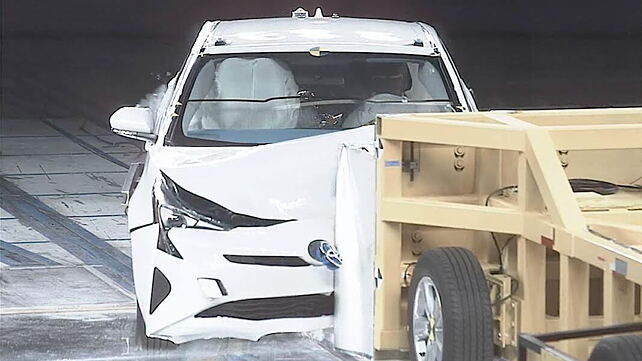
The Prius is Toyota’s first ever hybrid model and is widely regarded as the world’s largest selling hybrid. Introduced in 1997, this mass market eco-friendly model has led to the inception of plenty of plug-in hybrids and even zero-emission models. It’s also a testament to the safety of electrical components of Toyota’s hybrids and the latest-gen Prius is no different. The latter was recently subjected to Toyota’s new crash test format called an Oblique Crash Test.

In crash tests, the collisions are conducted in a straight line, however, Toyota’s version of it involved an object impacting a vehicle at an angle in high speed. The vehicle used in here was the latest-gen Prius which absorbed a large amount of impact to help protect the occupants, thanks to its collision-absorbing body structure. The safety features of the hybrid’s electrical components were also in place to ensure that electrical shocks are prevented. This is down to their layout, insulation and by cutting off electric supply in a crash.

The latest-gen Prius has been conceived using the Toyota New Global Architecture which helps the brand build cars using standardised platforms, powertrains and major components. With TNGA architecture, Toyota says it needs only five core platforms to develop a range of body styles right from a small sports car to an SUV.
The TNGA structure also allows for low-stance designs, giving the vehicles a lower centre of gravity and thereby better handling and stability. The high strength steel in the Prius allows it to have a 60 per cent more rigid body shell compared to before. It’s no surprise then that the new Prius fared well in the new crash test format set by Toyota.

![Toyota Prius [2009-2016] Image Toyota Prius [2009-2016] Image](https://imgd.aeplcdn.com/272x153/cw/cars/toyota/prius.jpg?q=80)















![Toyota Prius [2009-2016] Right Front Three Quarter Toyota Prius [2009-2016] Right Front Three Quarter](https://imgd.aeplcdn.com/199x112/ec/DA/51/10220/img/m/Toyota-Prius-Right-Front-Three-Quarter-49962_ol.jpg?v=201711021421&q=80)
![Toyota Prius [2009-2016] Rear View Toyota Prius [2009-2016] Rear View](https://imgd.aeplcdn.com/199x112/ec/DA/51/10220/img/l/Toyota-Prius-Rear-view-16091.jpg?v=201711021421&q=80)
![Toyota Prius [2009-2016] Exterior Toyota Prius [2009-2016] Exterior](https://imgd.aeplcdn.com/199x112/ec/DA/51/10220/img/l/Toyota-Prius-Exterior-16089.jpg?v=201711021421&q=80)
![Toyota Prius [2009-2016] Interior Toyota Prius [2009-2016] Interior](https://imgd.aeplcdn.com/199x112/ec/DA/51/10220/img/l/Toyota-Prius-Interior-16090.jpg?v=201711021421&q=80)
![Toyota Prius [2009-2016] Dashboard Toyota Prius [2009-2016] Dashboard](https://imgd.aeplcdn.com/468x263/ec/8228/img/l/3546.jpg?v=201711021421&q=80)


























